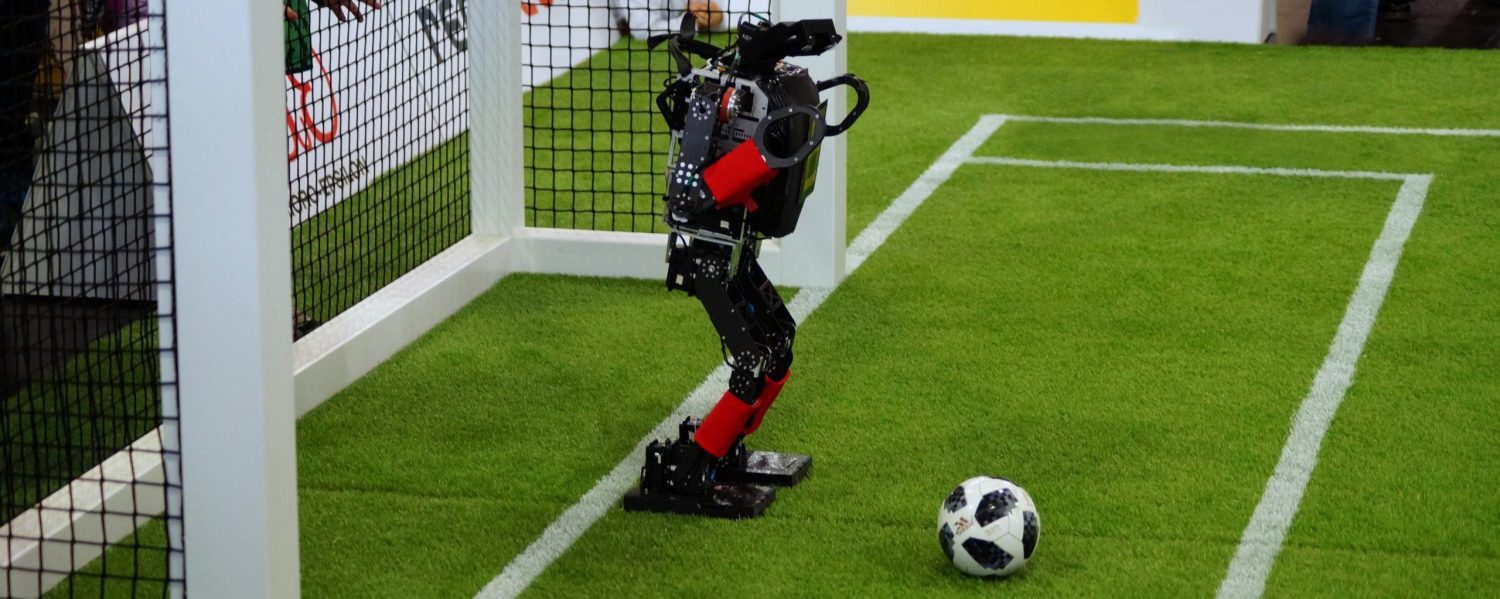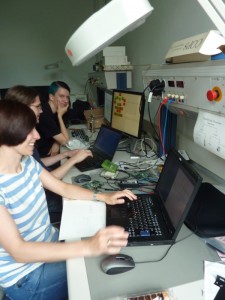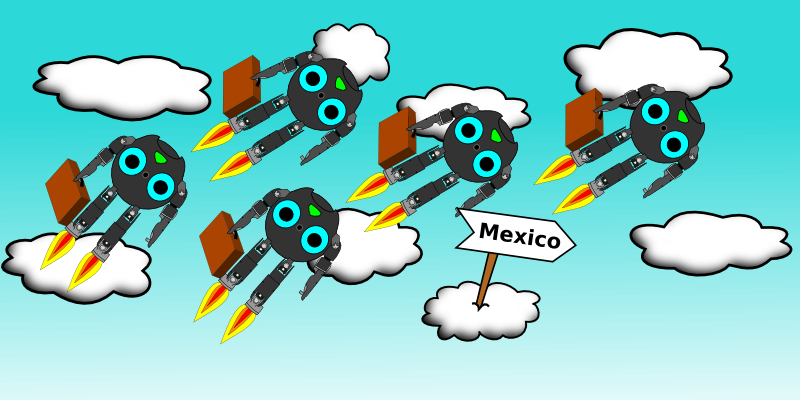It’s Day 4 now at home in Hamburg too. The 7 hour time offset makes it possible for the on-site team to commit the current code with tasks in the evening and let it be worked on overnight from the rest of the team in Hamburg.
Today finally is our first match at 12 o’clock pm (Mexico) and accordingly 7 o’clock pm (Hamburg). The team has made contact a short while ago and is now working parallel on the hoped-for success!
Cross your fingers!!! Our first opponent is a friendly and very successful team from Berlin.
Mexico: Day 4
We were busy working the whole day until 11 o’clock pm on programming and testing.
Now our players have a stable walk and the goalkeeper gets (nearly) every ball. For tomorrow (wednesday) it is planned to implement the elaborated behaviour for the outfield players.
Anything else? Oh, yes, we got a cool referee t-shirt.
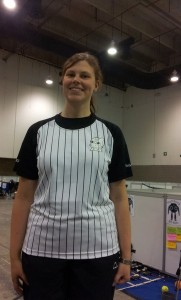

Match schedule
Here is the detailled schedule of the RoboCup 2012.
In the first round, every team plays against their respective groupmembers. The winner of the first place continues to the next group stage. The second-place finisher competes against the third-placed from another group to get on in the tournament.
Our first match in the group G will be against the Berlin United-FUmanoids.
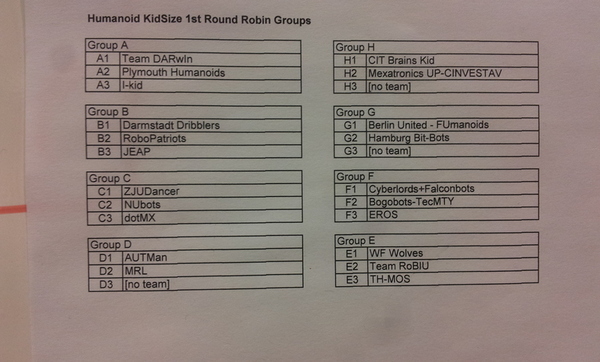
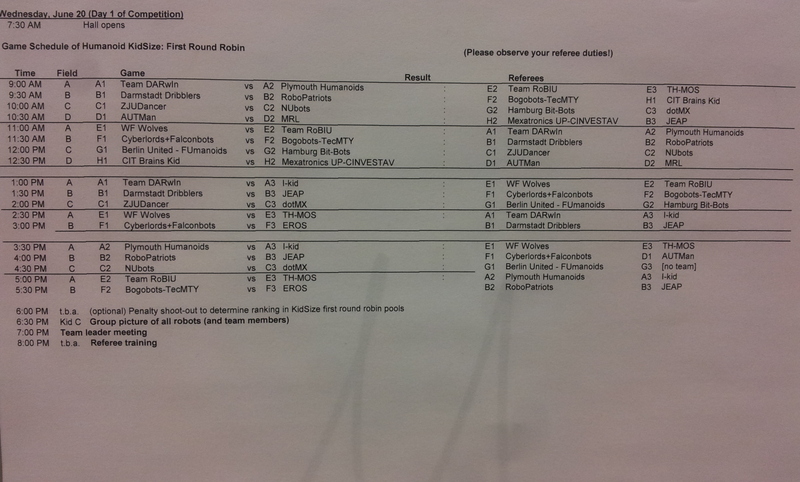
Mexico: Day 3
On the first day of RoboCup 2012 we wanted to be first to choose a nice working table, but the orga-team had upset our plans, since they opened up 30 minutes late and already assigned all the places by their own choice. So we were supposed to sit in a far discarded corner, but managed to negotiate a better table for our team later on.
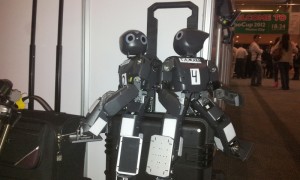
After preparing our new workspace, we went back to the hotel – right around the corner – to have some breakfast.
Thereafter we started programming. Even though it didn’t look well in the afternoon (nothing really worked), we were able to achieve some successes in the evening. We managed to improve our robots image processing in such a way, that the tracking of the game-ball works much faster now, which got us the nice side benefit of an improved behaviour of our goalkeeper and outfield players.
Mexico: Day 2
Today it was time for a bit of sightseeing in the city, so after having a good breakfast (remember our shopping tour from yesterday?) we went to the metro and used it to get to the Bosque de Chapultepec, a 4 km² large park.
There we met an Austrian team from the Junior Rescue League with whom we had a short conversation. Afterwards a rowing boat was rent to explore the Lago Chapultepec. Finally we wanted to visit the castle which stands on top of the hill. 
Having arrived there, we had to watch how everyone was allowed to enter the castle free of charge while we as tourists would have had to pay a special entrance fee. Very frustrated we went back to the hotel, which we reached soaked to the skin. Then after having a short lunch we went back to work.
Mexico: Day 1
The first day startet with a lot of sleep and some team members getting up late. Even before breakfast  the simple hotel room was converted into a lab.
the simple hotel room was converted into a lab.
The then following breakfast turned out quite poor, there was fresh orange juice, fried bread and strawberry jam. If you wanted something else, you would have had to buy it.
Afterwards we went into the supermarket which was an adventure in itself, as we had to take out our dictionary at every other product. But as the picture shows, it was something we also mastered.
What turned out much more difficult, was to find an adequate specialised store for electronics which sells an USB-to-Ethernet cable. After searching through the city for an hour we gave up at first, but later successfully found the proper piece in a Mac Store, that not only had the cable (allegedly only for Macusers) but also an in our project interested employee.
After and during this excursion we were busy working and it was already midnight when we all – tired and exhausted – went to bed.
Mexico!
We finally arrived, very tired, but we are here.
Here are 2 small impressions of the flight:
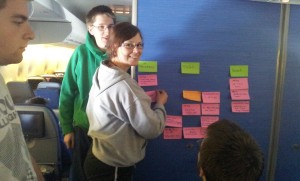
A long flight together with the whole team with a wall and notebooks, there you can begin to plan and to fix the bugs. Along the way we explained to the stewardess what we do and what the tasks on the wall means.
Now we’re going to sleep and tomorrow we will take it from there.
On the way to Mexico
Finally the stress of the preparation is past and the actual World Cup stress can begin.
This morning at 8:30 our robots mounted a plane together with their six-headed team of staff.
At first they went to Amsterdam and from there they flew over the Atlantic Ocean towards Mexico-City where they will be participating at the RoboCup2012 World Cup in the Humanoid Kid-Sized League.
The World Cup is already a success, simply alone to the fact that it got possible for us to participate. The international RoboCup-competition is a unique chance to have a real exchange of experiences with other teams, compare the own skills with those of other teams and learn from each other.
Although the competition itself is not the most important aspect to achieve this, naturally it provides a huge motivation for research and certainly quite a lot of fun for the participants too.
Of course we will try our best to reach a good place, even though this is our first World Cup.
As here is not enough space to individually thank all the people and institutions that have supported us in the last weeks – and the list would inevitably be incomplete, we say an overall thank you to the Department of Informatics at the University of Hamburg whose members and friends have supported us in various ways in the last weeks so that our participation at the World Cup succeeds.
We are in the know
Out of the blue they were there. Three customs officers with a serious look on their faces approached us and took our robots. We were asked to follow them! In a separate room an officer produced a rod and moved it along the robot. Afterwards the beeping machine …
And then we suddenly got a private photo appointment for GLaDOS. After we described the officers the amazing thing we planned to do with the robots we were allowed to take a picture on a seperate X-ray machine.
So this is how GLaDOS looks on a X-ray. You can even see a missing screw if you look closely. Thus it seems as if we have to acquire a X-ray machine too soon 😉
Now quickly written down our website for the customs officers and then on to the Boarding Gate – A39.
New member for the Bit-Bots
The World Cup is no longer far away, on friday our 4 robots together with the WTM substitute and their 6-headed human team of staff will board a plane and head towards Mexico where they will compete against teams from all over the world and collect very important experiences in robot soccer.
This means a lot of work for everyone involved and amongst other things a bit of suffering for our website.
But enough of the gibberish – did I say 4 robots?
Dead on time (no exaggeration) a fourth player did reach us. Just in time to be declared at customs has the robot, whose sponsorship this time kindly was assumed by the TAMS Group, arrived.
To illustrate our joy we have made the following video for you which shows the “birth” of the new Darwin.
